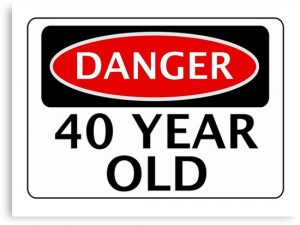Forty Years to Sink In.
Last week we discussed the Ammonites and their cousins the Moabites. Moishe placed both nations into the basket of deplorables. Men from both nations were forbidden from entering the congregation of the RBSO, meaning they could not marry nice Jewish girls. Even after conversion. Why not? The heylige Toirah told us both nations failed to come forth with bread and water when the Yiddin left Egypt. Ober guess what? This week’s parsha of Ki Sovoy -known mostly for containing the 98 curses the RBSO -through Moishe- threatened to send the way of the Yiddin for errant behavior, again features bread. This time it features bread and wine. Shoin, if the heylige Toirah saw fit for bread to be mentioned twice in two parshas, the Oisvorfer can, and will do the same. Let’s then begin towards the very end of the parsha. In fact, let’s begin at shi-v-ee (the 7th aliya) where the heylige Toirah (Devorim 29:1-6) tells us azoy:
| 1. And Moses called all of Israel and said to them, “You have seen all that the Lord did before your very eyes in the land of Egypt, to Pharaoh, to all his servants, and to all his land; | אוַיִּקְרָ֥א משֶׁ֛ה אֶל־כָּל־יִשְׂרָאֵ֖ל וַיֹּ֣אמֶר אֲלֵהֶ֑ם אַתֶּ֣ם רְאִיתֶ֗ם אֵ֣ת כָּל־אֲשֶׁר֩ עָשָׂ֨ה יְהֹוָ֤ה לְעֵֽינֵיכֶם֙ בְּאֶ֣רֶץ מִצְרַ֔יִם לְפַרְעֹ֥ה וּלְכָל־עֲבָדָ֖יו וּלְכָל־אַרְצֽוֹ: | |
| 2. the great trials which your very eyes beheld and those great signs and wonders. | בהַמַּסּוֹת֙ הַגְּדֹלֹ֔ת אֲשֶׁ֥ר רָא֖וּ עֵינֶ֑יךָ הָֽאֹתֹ֧ת וְהַמֹּֽפְתִ֛ים הַגְּדֹלִ֖ים הָהֵֽם: | |
| 3. Yet until this day, the Lord has not given you a heart to know, eyes to see and ears to hear. | גוְלֹֽא־נָתַן֩ יְהֹוָ֨ה לָכֶ֥ם לֵב֙ לָדַ֔עַת וְעֵינַ֥יִם לִרְא֖וֹת וְאָזְנַ֣יִם לִשְׁמֹ֑עַ עַ֖ד הַיּ֥וֹם הַזֶּֽה: | |
| 4. I led you through the desert for forty years [during which time] your garments did not wear out from upon you, nor did your shoes wear out from upon your feet. | דוָֽאוֹלֵ֥ךְ אֶתְכֶ֛ם אַרְבָּעִ֥ים שָׁנָ֖ה בַּמִּדְבָּ֑ר לֹֽא־בָל֤וּ שַׂלְמֹֽתֵיכֶם֙ מֵֽעֲלֵיכֶ֔ם וְנַֽעַלְךָ֥ לֹא־בָֽלְתָ֖ה מֵעַ֥ל רַגְלֶֽךָ: | |
| 5. You neither ate bread, nor drank new wine or old wine, in order that you would know that I am the Lord, your God. | הלֶ֚חֶם לֹ֣א אֲכַלְתֶּ֔ם וְיַ֥יִן וְשֵׁכָ֖ר לֹ֣א שְׁתִיתֶ֑ם לְמַ֨עַן֙ תֵּֽדְע֔וּ כִּ֛י אֲנִ֥י יְהֹוָ֖ה אֱלֹֽהֵיכֶֽם: | |
| 6. And then you arrived at this place. And Sihon, the king of Heshbon, and Og, the king of Bashan, came out towards us in battle, and we smote them. | ווַתָּבֹ֖אוּ אֶל־הַמָּק֣וֹם הַזֶּ֑ה וַיֵּצֵ֣א סִיחֹ֣ן מֶֽלֶךְ־חֶ֠שְׁבּ֠וֹן וְע֨וֹג מֶֽלֶךְ־הַבָּשָׁ֧ן לִקְרָאתֵ֛נוּ לַמִּלְחָמָ֖ה וַנַּכֵּֽם: |
What is going on here? Just last week Moishe lamented the fact that neither Ammonites nor Moabites sold the Yiddin bread. Ober we found sources elsewhere in the Toirah which revealed that Moishe and the Yiddin did in fact buy bread and water. Did they or didn’t they buy and eat bread? Whose bread was eaten? Who sold them bread? And we ask again: why did they need bread? Were they not on a steady 40 year diet of Mun (manna from heaven)? How can once compare bread to mun? Bread always tastes like bread, ober the Mun -based on what chazal (our sages) have taught us- tasted like anything one wanted or could imagine. Given the choice would you pick bread over manna? Ver veyst. And we have a few more questions before the Oisvorfer -having studied several independent sources- attempts to tie this all together.
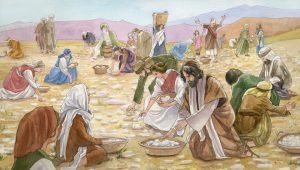 In posik Gimmel (verse 3) above, Moishe tells the Yiddin that they were incapable, until now -meaning these past 40 years- of understanding what the RBSO wanted from them. Moreover, their eyes could not see and their ears could not hear. Ober shtelt zich di shaylo (the question arises), azoy: if they could not understand what the RBSO wanted from them, why were they constantly being punished? Shouldn’t punishment be meted out only when one understands and then does not follow rules? What’s pshat here? Says Rashi: therefore the RBSO was not particular with you until this day. In other words: He went easy on you because He chaps that it took 40 years until His commandments sank into your farshtupta (thick) heads. Ober is that emes? He went easy on the Yiddin? Did the RBSO not declare that the entire generation of men between the ages of 20 and 60 were to die out in the midbar? He did. Did he not dispense with those involved in the eygel (golden calf)? And those who partied hearty with the Moabite women? And so many others? He did! Was that going easy? Ver veyst? Well, compared to the 98 curses found in our parsha, perhaps He was?! And says Rashi quoting the heylige Gemora (Avoido Zoro 5-B), azoy: no person can appreciate the depths of his teacher’s mind or the profundity of his teachings before 40 years. It takes maims 40 years to understand what the teacher or rebel is trying to convey? Well blow me down: that excuse never did fly when the future Oisvorfer trying was getting smacked around for not following the rebbe’s shiur. Nor anyplace else! The bottom line: The RBSO -at least in this week’s parsha- meant business. It was His. Period end discussion.
In posik Gimmel (verse 3) above, Moishe tells the Yiddin that they were incapable, until now -meaning these past 40 years- of understanding what the RBSO wanted from them. Moreover, their eyes could not see and their ears could not hear. Ober shtelt zich di shaylo (the question arises), azoy: if they could not understand what the RBSO wanted from them, why were they constantly being punished? Shouldn’t punishment be meted out only when one understands and then does not follow rules? What’s pshat here? Says Rashi: therefore the RBSO was not particular with you until this day. In other words: He went easy on you because He chaps that it took 40 years until His commandments sank into your farshtupta (thick) heads. Ober is that emes? He went easy on the Yiddin? Did the RBSO not declare that the entire generation of men between the ages of 20 and 60 were to die out in the midbar? He did. Did he not dispense with those involved in the eygel (golden calf)? And those who partied hearty with the Moabite women? And so many others? He did! Was that going easy? Ver veyst? Well, compared to the 98 curses found in our parsha, perhaps He was?! And says Rashi quoting the heylige Gemora (Avoido Zoro 5-B), azoy: no person can appreciate the depths of his teacher’s mind or the profundity of his teachings before 40 years. It takes maims 40 years to understand what the teacher or rebel is trying to convey? Well blow me down: that excuse never did fly when the future Oisvorfer trying was getting smacked around for not following the rebbe’s shiur. Nor anyplace else! The bottom line: The RBSO -at least in this week’s parsha- meant business. It was His. Period end discussion.
Ober, if that is emes and it taka takes 40 years to chap and understand any given mitzvah, we need to look at the group of Yiddin Moishe assembled back in posik aleph (verse 1). If Moishe taught the Yiddin approximately 200 new mitzvis in the 40th year -meaning in the months just before entering the Promised Land- how could they be held responsible for violating them if they never had the understanding of just what the RBSO wanted from? Ver veyst!
 Shoin, let’s tackle the bread issue. As a literal reading of Moishe’s words tell us that the Yiddin did not in fact consume any bread or intoxicants during the past 40 years. Ober is that the emes? Says the RambaN: we should not read these words literally. Why not? Because they are seemingly not the emes. They ate bread? And drank intoxicants? Say it’s not so! Says the RambaN -having studied other pisukim found earlier and in particular what Moishe said in Devorim 2:29: the Yiddin did eat bread. Settled? Seemingly they ate bread but not enough to sustain them. In other words: Mun, which fell daily, six days a week, is what sustained them and also allowed them to skip having to go to the bathroom. Bread was -from time to time- available in the midbar. Ober what’s with the bathroom? Shoin, medrish tells us that the Mun had magical properties and among them, was that it was tonally consumed by the body and produced no waste. In plain English: those who ate Mun did not need to defecate. Nice. Ober those who ate bread -when available- did in fact need to use the facilities. Were there facilities in the Midbar? No! Ober, they made their own. Shoin.
Shoin, let’s tackle the bread issue. As a literal reading of Moishe’s words tell us that the Yiddin did not in fact consume any bread or intoxicants during the past 40 years. Ober is that the emes? Says the RambaN: we should not read these words literally. Why not? Because they are seemingly not the emes. They ate bread? And drank intoxicants? Say it’s not so! Says the RambaN -having studied other pisukim found earlier and in particular what Moishe said in Devorim 2:29: the Yiddin did eat bread. Settled? Seemingly they ate bread but not enough to sustain them. In other words: Mun, which fell daily, six days a week, is what sustained them and also allowed them to skip having to go to the bathroom. Bread was -from time to time- available in the midbar. Ober what’s with the bathroom? Shoin, medrish tells us that the Mun had magical properties and among them, was that it was tonally consumed by the body and produced no waste. In plain English: those who ate Mun did not need to defecate. Nice. Ober those who ate bread -when available- did in fact need to use the facilities. Were there facilities in the Midbar? No! Ober, they made their own. Shoin.
Moreover, the heylige Gemora (Yoma 75b) tells us bifeirush (in plain Aramaic and now translated into English by Rabbi Art Scroll) that the Yiddin did purchase bread and other food items from peddlers of the nations of the world who set up shop as the Yiddin were passing through. And what Moishe must have meant when he said that the Yiddin did not eat bread, was that the purchased bread wasn’t enough to sustain them throughout their sojourns. Alternatively, efsher we can kler that it’s taka emes that the Yiddin did not eat bread for kimat 40 years. Well, at least 39 years. Ober in the 40th year, as they approached inhabited areas and needed to wage war against those who war occupying lands they needed to capture, they did in fact purchase and eat bread. Bottom line: it appears that they did eat bread.
Ober was the bread they purchased kosher? Did it have a hechsher? Was it pas yisroel (baked by a Jew)? Clearly it was not! Did it matter? Seemingly not. Why not? Because at that time, it must have been understood that bread contained but flower and water. Shoin. It would take many generations before a few enterprising Yiddin decided that bread and even water, require some form of a water (kosher certification) and shoin.
So happens that besides the dreaded Toichocho, the parsha has a few other pearls and mitzvois to mine. Some say it’s six. Let’s focus on one of them. To chap it, we must begin by quoting a few pissukim of the heylige Toirah (Devorim 27: 1-6) which says azoy:
“On the day that you cross the Jordan to the land which the Lord your G-d gives you, you shall set up great stones and plaster them with lime. And you shall write upon them all the words of this Toirah…you shall set up these stones, which I command you this day, in Mount Ebal. There you shall build an altar unto the Lord your G-d, an altar of stones; you shall lift no iron tool upon them. You shall build the altar of the Lord your G-d of unhewn stones; and you shall offer burnt-offerings on it unto the Lord your G-d. And you shall write upon the stones all the words of this law very plainly.” And shoin, long before Art Scroll envisioned the Stone Edition of the Chumash (Chumish in yeshiva reydt or language), stones seemingly played a significant part in the heylige Toirah. What exactly were the Yiddin to do, how many stones were involved, where they come from and many more questions are raised by these few pisukim. And as you can only imagine, these passages were the subject of many discussions and machloikes between many in the heylige Gemora and other places. What were they arguing about? About real pshat in the instructions which can of course lead to some confusion and many interpretations. Welcome to the heylige Toirah. Is it a wonder some say the Toirah has 70 faces.
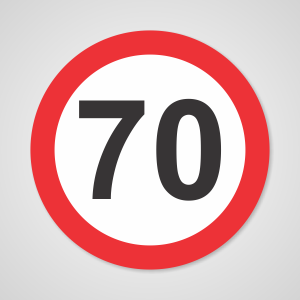 And because you never knew any of this, we will dedicate a page or two to enlighten you and efsher enhance your shabbis tish.
And because you never knew any of this, we will dedicate a page or two to enlighten you and efsher enhance your shabbis tish.
Seemingly, Moishe and the elders commanded the people, that when they crossed the Jordan River (Yehoishua would lead them following Moishe’s passing), the very first mitzvah they were to perform was to pick up twelve large stones from the river bed (one stone corresponding to each tribe) and carry them into the Promised Land. Does everyone agree that there were 12 stones? Of course not! And says the heylige Gemora (Soitah 34a) azoy: there were three sets of stones, each consisting of twelve stones, and not just one. Shoin, whether there was one large stone or 12 or 36, ver veyst. Let’s go veyter.
Once there, they were to take them to Har Gerizim and Har Eival, two mountain tops, construct a Mizbei’ach (altar) with them and lime them. And then? They were to write or inscribe them. Write what? Let’s see those words again: the instructions were “and write on them all the words of this Toirah” ober which words? All the words? Some words and which words? How many words can fit onto 12 or even 36 stones? How large were the stones and what were they using for writing instruments? How were such large stones transported? So many excellent kashas, none of which you likely recall learning answers to. Let the Oisvorfer enlighten you with a few potential answers. Of course these are only potential answers because few agree on any one detail. Welcome to Toirah learning 101.
Nu, some are of the opinion that the entire heylige Toirah was to be written or etched into the stones. Others say that’s nothing: the entire heylige Toirah, in all 70 languages of the people needed to be inscribed so that all of mankind and maybe also womankind, would be able to read the stones. In how many languages? Some say 70 and some say 71. Why these numbers? Nu, efsher you recall that the RBSO, following the tower of Buvel incident, dispersed the people into 70 nations each with their own unique language. And the 71st? That would be loshoin koidesh (holy script, our very own language). Of course, this didn’t sit well with others who asked how that was possible? How could 12 or 36 stones fit all this information? Not to worry because says the Ramban azoy: One possibility was that only the 613 mitzvois were written, not the entire Toirah. Another view suggests that taka the entire Toirah, from the first letter in Sefer Bereishis to the very last in Sefer Devorim, was recorded but how? Is that your business? If the RBSO said to do it, mistama He had a plan even if that plan was miracle dependent. Can the RBSO not perform miracles? So pshat is like this. Either the stones were enormous and avada we can chap that big stones are sometime better than little stones, or it was a neys mamish (miraculous scribal feat) that allowed this to happen. Why not? Didn’t the RBSO perform other miracles that you seem to accept without questioning? Veyter!
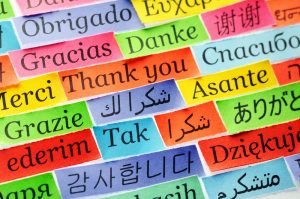 Why would the RBSO require that His Toirah be etched into stone in 70 or 71 languages? How long would that take, who knew these languages and which of the non-Jewish nations would care about the RBSO’s Toirah? Ver veyst. Moreover, the Yiddin have yet to agree on one unified translation of the heylige Toirah, how were they going to etch it into 70 languages? Ver veyst? In any event, the heylige Gemora does present one logical argument on how this could have happened.
Why would the RBSO require that His Toirah be etched into stone in 70 or 71 languages? How long would that take, who knew these languages and which of the non-Jewish nations would care about the RBSO’s Toirah? Ver veyst. Moreover, the Yiddin have yet to agree on one unified translation of the heylige Toirah, how were they going to etch it into 70 languages? Ver veyst? In any event, the heylige Gemora does present one logical argument on how this could have happened.
Not to worry because said Reb Saadya Ga’on that only the Taryag Mitzvos (613 commandments) were written on the stones. Ober says the Toirah Temimah azoy: only the 10 commandments were written down. Some say that only the 98 “curses” of the toichoco (rebuke) is what was written on the stones. Ober said the Kisav VehaKabala that only the Shema was recorded in stone. Which was it, ver veyst? And said Don Yitzchak Abarbanel, (Commentary on Sefer Devorim, 252b) azoy: only Sefer Devorim was inscribed onto the stones. Shoin, is it wonder the Yiddin don’t agree on anything?
How many stones were there? Says the heylige Gemora (Soitah 34a) azoy: there were taka three sets of stones, each consisting of twelve stones, and not just one. That’s 36 stones. The first set contained the words of the Toirah in all languages and was erected by Moishe in Arvos Moi’av (plains of Moiav) when he re-established the covenant that the Yiddin had broken and nullified with the eygel (golden calf) incident. The second set, at the behest of Yehoishua, were placed in the Yarden (Jordan River) itself as the Yiddin crossed over. For what purpose you may be wondering? Says Rabeinu Bachye, the function of this set was for the Kohanim (priests) who stood their ground holding the Aron whilst the people crossed, until the water returned to its original course, to stand on, to avoid having to stand in the mud. This makes it unlikely for the Toirah to have been written on them, though in any event, there is no indication that it was. Gishmak. And the third set was initially erected on Har Eival in the form of a Mizbei’ach, as we explained, and then, after sacrificing on it, they took it apart and carried the stones to Gilgal, where they spent their first night in the holy land, and where they re-erected them. Got all that?
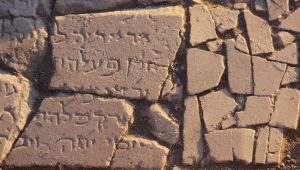 One Medrish will tell us that at least two miracles occurred in connection with these stones. Ershtens, both mountains, Har Gerizim and Har Eival were a distance of sixty Mil (one and a half days walking distance). Yet the Yiddin traveled there, set up the stones, wrote the entire Toirah on them in all seventy-one languages (70 plus the original Toirah language) and went through the entire ceremony described in this parshah and returned, all before nightfall. Ober says the Ramban, based on his assumption that the stones were not that gigantic, azoy: the Yiddin were able to write the entire Toirah on them seventy-one times, with all the Tagin (crowns) and that was a miracle too. In the end, of course there is no consensus. How large were the stones? The heylige Gemora (Soitah 34a) tells us that the volume of each stone was forty Sa’ah (one Amah by one Amah by three Amos. And how large is that? The measurement of a minimum size Mikvah.
One Medrish will tell us that at least two miracles occurred in connection with these stones. Ershtens, both mountains, Har Gerizim and Har Eival were a distance of sixty Mil (one and a half days walking distance). Yet the Yiddin traveled there, set up the stones, wrote the entire Toirah on them in all seventy-one languages (70 plus the original Toirah language) and went through the entire ceremony described in this parshah and returned, all before nightfall. Ober says the Ramban, based on his assumption that the stones were not that gigantic, azoy: the Yiddin were able to write the entire Toirah on them seventy-one times, with all the Tagin (crowns) and that was a miracle too. In the end, of course there is no consensus. How large were the stones? The heylige Gemora (Soitah 34a) tells us that the volume of each stone was forty Sa’ah (one Amah by one Amah by three Amos. And how large is that? The measurement of a minimum size Mikvah.
And the bottom line? In the end, we accept that if the RBSO ordered that His Toirah be etched into stone, be it on the original set which Moishe brought down with the Ten Commandments, or the second replacement set, following a shtikel debacle, or, on the 12 or 36 stones referenced in our parsha, there must be a good reason. Exactly what that reason was, is of course none of our business. During this time of year, it’s the RBSO asking questions about what we’ve been doing with our stones, if you chap.
A gittin Shabbis!
The Heylige Oisvorfer Ruv
Yitz Grossman

